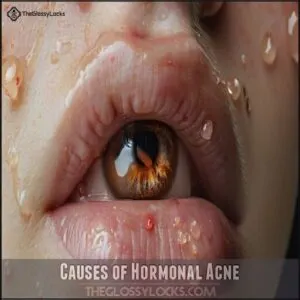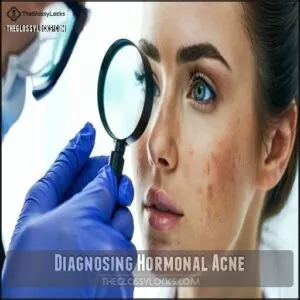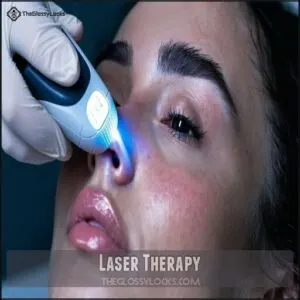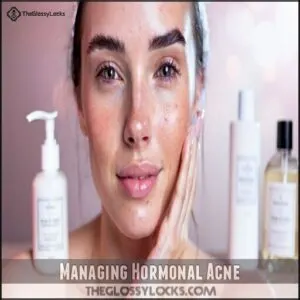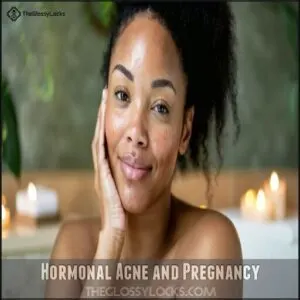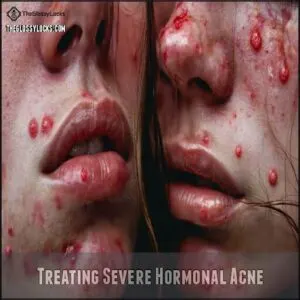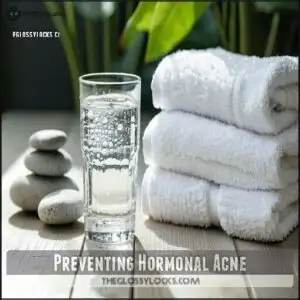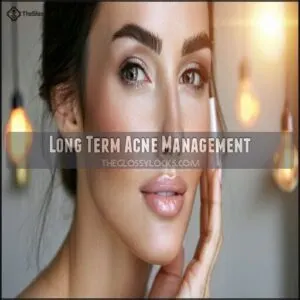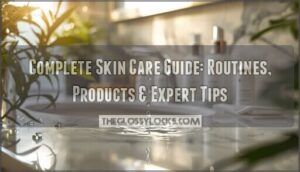This site is supported by our readers. We may earn a commission, at no cost to you, if you purchase through links.
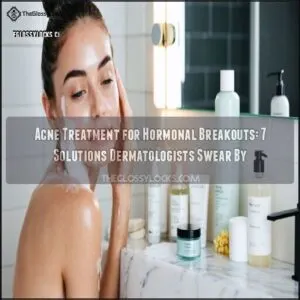
Start with gentle skincare—use cleansers with salicylic acid or benzoyl peroxide to unclog pores and fight inflammation. If cystic acne’s crashing your party, topical retinoids or a dermatologist-prescribed cream can work wonders.
For stubborn breakouts, oral treatments like birth control pills or spironolactone balance hormones effectively. Got stress? Managing it with sleep and exercise helps too.
And don’t forget: what you eat matters—limit sugar and dairy. Consistency is key! With the right plan, you’ll feel like you’re finally in the driver’s seat.
Curious about lasting solutions? Keep reading.
Table Of Contents
- Key Takeaways
- Who Gets Hormonal Acne
- Causes of Hormonal Acne
- Symptoms of Hormonal Acne
- Diagnosing Hormonal Acne
- Treatment Options Available
- Managing Hormonal Acne
- Hormonal Acne and Pregnancy
- Treating Severe Hormonal Acne
- Preventing Hormonal Acne
- Long Term Acne Management
- Frequently Asked Questions (FAQs)
- Conclusion
Key Takeaways
- Focus on gentle skincare with ingredients like salicylic acid or benzoyl peroxide, and consider prescription treatments for stubborn acne.
- Balance hormones through options like birth control pills, spironolactone, or stress reduction with exercise and better sleep.
- Make dietary changes by cutting back on sugar and dairy while adding more omega-3s and antioxidant-rich foods.
- Stick to a consistent skincare routine, manage stress, and adjust treatments as needed to keep breakouts under control.
Who Gets Hormonal Acne
You’ll likely face hormonal acne if you’re among the 80% of adults aged 20-50, with women experiencing it more frequently due to menstrual cycles, pregnancy, or menopause.
Your risk increases if you have oily skin, a family history of acne, or conditions like PCOS that affect hormone levels, making hormonal acne a significant concern.
Adults Affected by Acne
The mirror doesn’t lie—hormonal acne isn’t just a teenage problem.
Adult acne affects millions globally, with cases rising 10% among women in the past decade. You’re not alone if you’re dealing with these frustrating breakouts.
Consider these facts about adult hormonal acne:
- It affects over 640 million adults worldwide
- More than 25% of women in their 40s report having acne
- Adult acne can range from mild to severe, requiring different treatment approaches, which can be a complex issue.
Women and Hormonal Acne
While acne affects many adults, women face unique hormonal challenges.
Your menstrual cycle creates a predictable pattern of breakouts that can feel like clockwork.
| Hormonal Factor | Impact on Women’s Acne |
|---|---|
| Menstrual Cycle | Breakouts 1-2 weeks before period |
| PCOS Impact | Persistent chin/jawline cysts |
| Pregnancy Acne | Often appears in first trimester |
| Menopause Breakouts | New acne despite aging skin |
| Birth Control | Can improve or worsen symptoms |
Understanding these connections helps you find effective hormonal acne treatments.
This knowledge is crucial for managing persistent chin/jawline cysts and menstrual cycle breakouts, leading to better skin health.
Men and Hormonal Acne
While women frequently battle hormonal breakouts, men aren’t immune to this skin challenge.
Testosterone levels play a significant role in male hormonal acne, triggering excess sebum production that clogs pores.
You’ll typically notice these deeper pimples on the face, chest, and back where men have more sebaceous glands. Almost 85% of young men develop acne between ages 12-25, with symptoms often being more severe due to androgen sensitivity.
This condition affects a significant portion of the population, making hormonal acne a common issue.
Causes of Hormonal Acne
Your hormonal acne stems from excess oil production when hormones like testosterone trigger your skin’s oil glands to work overtime.
Hormonal acne thrives when testosterone fuels oil glands, creating the perfect storm for stubborn breakouts on your chin and jawline.
These oils mix with dead skin cells and bacteria, clogging your pores and creating those frustrating breakouts that often appear on your chin and jawline, which is a result of hormonal imbalance.
Benefits Of Regular Exercise
Regular exercise offers surprising benefits for your hormonal acne.
When you work out, improved circulation delivers oxygen to skin cells while reducing inflammation that triggers breakouts.
Exercise also helps balance hormones naturally and reduces stress—a major acne contributor.
Even 30 minutes of activity three times weekly enhances immunity and supports overall skin health, making it a simple yet effective addition to your acne-fighting lifestyle changes.
Improving Mental Health Strategies
Mental health plays a vital role in managing hormonal acne.
Stress triggers hormone fluctuations that can worsen breakouts. Try mindfulness practices and cognitive restructuring to lower stress levels.
Building strong support systems helps maintain self-compassion when acne affects your self-esteem. Remember, hormonal acne isn’t your fault – it’s a medical condition.
Practicing stress reduction techniques like deep breathing or meditation can substantially improve both your skin and mental wellbeing.
Healthy Lifestyle Tips
Beyond managing your skincare routine, adopting healthy lifestyle habits can substantially impact hormonal acne.
A balanced diet rich in omega-3s and antioxidants helps regulate hormones naturally. Try reducing dairy and sugar intake while increasing nutrient-rich foods.
Don’t underestimate the power of adequate sleep, regular exercise, and stress reduction techniques like meditation.
Staying well-hydrated and limiting alcohol consumption can also improve your skin’s appearance and overall health.
Symptoms of Hormonal Acne
You’ll notice hormonal acne appears as painful, deep cysts mainly on your chin and jawline, often flaring up before your period.
These stubborn breakouts can also show up as red, inflamed bumps on your lower face and sometimes chest or back, unlike regular acne that appears more randomly across your skin, characterized by painful and deep cysts.
Common Acne Symptoms
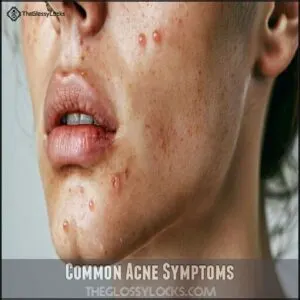
Now that you understand what causes hormonal acne, let’s identify what it actually looks like.
Common symptoms of hormonal breakouts include whiteheads, blackheads, papules (small red bumps), and pustules (pimples with pus).
You’ll often notice these appearing on your chin and jawline.
Cystic hormonal acne—those painful, deep bumps—can also develop.
These symptoms typically flare up before or during your period when hormones fluctuate most dramatically.
Severe Acne Symptoms
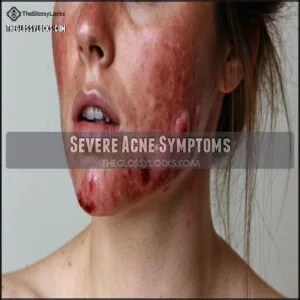
Behind the typical pimples, severe hormonal acne brings more challenging symptoms.
You’ll know you’re dealing with something serious when you experience:
- Painful nodules that feel hard beneath the skin
- Deep cystic breakouts that don’t come to a head
- Persistent inflammation lasting weeks
- Treatment resistance to standard products
- Increased scarring risks from deeper skin damage
These symptoms often signal the need for professional hormonal acne treatment.
Acne on Face and Body
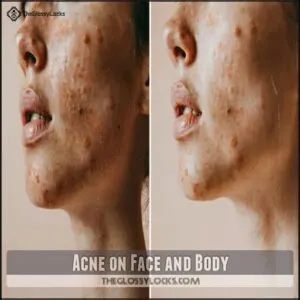
Hormonal acne doesn’t just target your face—it spreads to multiple areas of your body.
You’ll typically notice facial acne types on your chin, jawline, and forehead where oil glands are most active. Body acne locations often include your chest, back, and shoulders.
Using the acne severity scale helps determine appropriate treatments. Remember, early intervention prevents post-acne marks and scarring.
Consistent treatment of hormonal breakouts is key to managing both face and body symptoms. Often, this acne is linked to hormonal shifts, which requires hormonal balance and consistent treatment to prevent long-term effects.
Diagnosing Hormonal Acne
You’ll need a proper diagnosis to confirm if those stubborn breakouts along your jawline and chin are truly hormonal acne.
Your dermatologist will examine your skin patterns and discuss your medical history, including menstrual cycles and medication use, to determine the right treatment approach for your specific case, which involves a thorough understanding of your medical history.
Physical Examination
Now that you know what hormonal acne looks like, let’s talk about what happens during a physical examination for diagnosis.
When you visit a dermatologist for acne concerns, they’ll perform a thorough skin assessment that typically includes:
- Lesion identification (counting and classifying pimples, cysts, and blackheads)
- Inflammation check across problem areas
- Palpation findings to determine depth and tenderness.
Your doctor will examine affected areas under good lighting to determine the specific type of hormonal acne you’re dealing with, using techniques such as lesion identification.
Medical History
Your health detective work matters when diagnosing hormonal acne.
Your doctor will ask about past treatments that worked (or didn’t), family history of acne, current medications, and any allergies you have.
They’ll check for underlying conditions like polycystic ovary syndrome or hormonal imbalance that might trigger breakouts.
Birth control history is especially important, as hormonal fluctuations often hold the key to effective treatment.
Skin Analysis
After reviewing your medical history, your dermatologist will examine your skin closely to determine the best hormonal acne treatment path.
During skin analysis, professionals measure:
- Sebum production rate (oil levels)
- Pore size and blockage patterns
- Skin hydration levels
- Specific areas of inflammation
- Skin type and sensitivity
This detailed assessment helps create a personalized skin care routine that addresses your unique acne and hormones relationship, ensuring treatments target your specific concerns.
Lifestyle adjustments, like managing stress and maintaining consistent sleep, can also substantially impact hormonal acne.
Treatment Options Available
You’ll find several effective options for treating hormonal breakouts, from prescription medications to professional procedures.
Your treatment plan may include topical creams, oral medications, or laser therapy, depending on your acne’s severity and your skin’s unique needs.
Topical Creams and Gels
Five effective topical medications can tackle your hormonal acne head-on.
Topical retinoids like tretinoin clear blackheads and whiteheads by promoting cell turnover.
For inflammatory acne, you’ve got options: topical antibiotics reduce bacteria, while benzoyl peroxide fights inflammation.
If those cause irritation, try azelaic acid as a gentler alternative.
These treatments work at the skin’s surface, making them your first line of defense against hormonal breakouts.
Many people find relief using topical retinoid products.
Oral Medications
Oral medication powerhouses offer effective solutions for stubborn hormonal acne.
Your dermatologist might prescribe birth control pills to regulate hormone levels, especially if you have flare-ups during periods.
Spironolactone, a popular anti-androgen, blocks testosterone effects that cause excess oil.
For severe cases, isotretinoin delivers dramatic results but carries risks requiring careful monitoring.
Most hormonal acne treatments need 4-6 months to show full benefits, so patience is key.
Laser Therapy
When medications don’t quite hit the mark, laser therapy offers a non-invasive solution for stubborn hormonal acne.
The AviClear laser specifically targets acne at its source, working deep beneath the skin to reduce inflammation and bacteria.
You’ll need multiple sessions, but many patients see lasting improvement without constant maintenance.
Better yet, it’s safe for all skin types, though costs can range from $300-1000 per treatment.
Laser therapy can target acne-causing bacteria and reduce inflammation.
Managing Hormonal Acne
You can manage hormonal acne with daily habits that balance your body’s internal systems.
Controlling stress levels, eating fewer processed foods, and using gentle skincare products will help reduce those stubborn chin breakouts.
That show up right before your period.
Lifestyle Changes
Beyond medications, simple lifestyle changes can make a big difference for hormonal acne.
Getting regular exercise helps balance hormones and reduce stress that triggers breakouts.
Aim for 7-8 hours of sleep to allow skin repair time.
Establish a consistent skincare routine with gentle cleansers, and remember that small changes add up – even washing pillowcases weekly can prevent bacteria buildup that worsens hormonal acne, which is why regular exercise is also crucial.
Diet and Nutrition
While good habits help clear your skin, what you eat directly affects hormonal acne too.
Your gut health plays a key role in skin inflammation.
Try these diet changes:
- Cut back on high-glycemic foods like white bread and sugary snacks
- Limit dairy consumption which may trigger breakouts
- Eat anti-inflammatory foods like berries and leafy greens
- Drink more water to flush toxins
Stress Management
In the face of hormonal acne, stress management becomes your secret weapon.
When stress levels rise, your body produces more cortisol, triggering excess oil production.
Try mindfulness practices like deep breathing or meditation for just 5 minutes daily.
Improve sleep hygiene by keeping regular hours.
Simple relaxation techniques—yoga, walking, or a warm bath—can help develop healthy coping mechanisms that break the stress-acne cycle.
Some find relief through products targeting stress.
Hormonal Acne and Pregnancy
If you’re pregnant and dealing with hormonal acne, you’ll need treatments that are safe for both you and your baby.
Your changing hormone levels can trigger breakouts, but certain gentle options can effectively manage pregnancy acne without risk.
Acne During Pregnancy
The surprising truth: over half of pregnant women develop hormonal acne.
Surging hormones during pregnancy boost oil production, clogging pores and triggering those unwanted breakouts.
Your changing immune system also plays a role in pregnancy-related acne flares.
- Nodular acne (deep, red, painful bumps) often appears during pregnancy
- First trimester typically brings the worst breakouts
- Acne may extend beyond your face to neck, chest and back
- Breastfeeding can actually help keep postpartum breakouts away
Safe Treatments for Pregnant Women
While managing acne during pregnancy requires extra caution, several safe options exist.
Topical treatments like azelaic acid and glycolic acid get the green light from doctors.
Benzoyl peroxide can be used in limited amounts, and certain topical antibiotics like erythromycin work well too.
For natural remedies, try diluted apple cider vinegar as a toner or honey as a spot treatment.
Always check with your doctor before starting any acne treatment during pregnancy.
Preventing Acne During Pregnancy
Acne during pregnancy can be tricky, but prevention starts with small steps.
Opt for dermatologist-approved, safe cleansers and gentle exfoliation to keep skin clear without irritation.
Hormonal acne loves stress, so focus on stress reduction and relaxation.
Pair these with dietary changes and natural remedies, like more water and leafy greens, for a glow that’s baby-safe and beautiful.
Treating Severe Hormonal Acne
When severe hormonal acne takes over, it’s time to focus on targeted solutions that tackle the problem at its root.
Treatments like isotretinoin, antibiotics, or hormone-regulating therapies can work effectively to restore balance and clear stubborn breakouts.
Isotretinoin Therapy
If pregnancy-safe options didn’t work, isotretinoin might be the reset button your skin needs.
This powerful hormonal acne treatment targets root causes like excess oil.
Treatment duration usually lasts 4-6 months, with isotretinoin dosage adjusted to you.
It’s serious business—potential side-effects and regular monitoring requirements mean it’s not for everyone.
Always discuss alternative therapies with your dermatologist.
Antibiotic Treatments
If severe hormonal acne feels like it’s winning, antibiotics can help.
Oral antibiotics fight bacteria and reduce inflammation, though treatment duration varies.
Topical antibiotics work directly on affected spots, but overuse can lead to antibiotic resistance.
Side effects like upset stomachs or skin irritation are possible, so always follow your doctor’s advice.
This acne treatment fits when other options don’t deliver, making it a useful solution for severe cases, with doctors often recommending it as a last resort.
Hormone Regulation
If antibiotics didn’t work, targeting hormones might.
Hormone testing helps identify imbalances, while treatments like spironolactone or androgen blockers manage excess androgens causing breakouts.
Birth control pills balance hormones in women, offering clearer skin.
Pair these with natural remedies and consistent care.
For resistant hormonal acne, hormonal imbalance treatments bring relief, restoring control and confidence.
Preventing Hormonal Acne
You can reduce hormonal acne by sticking to a simple, consistent skincare routine and avoiding known triggers like stress and oily products.
Healthy habits, like staying hydrated and eating a balanced diet, also play a big role in keeping breakouts at bay, which can be achieved by following a consistent skincare routine.
Skincare Routine
Your skin care routine can make or break your battle with hormonal acne. Focus on simple steps that work:
- Wash gently twice a day using noncomedogenic cleansers.
- Try exfoliation methods weekly to unclog pores without overdoing it.
- Stick to products labeled noncomedogenic and prioritize hydration.
Consistency’s key. Tea tree oil can be beneficial for acne-prone skin. Treat your skin like a loyal friend—it needs patience and attention, not chaos.
Avoiding Triggers
Steering clear of triggers can make a world of difference for hormonal acne.
Skip harsh skincare products and check labels for pore-clogging ingredients.
Manage stress with exercise or meditation, stick to good sleep hygiene, and rethink dietary choices—cutting out sugary, processed foods might help.
Review medications with your doctor if needed, since some can worsen breakouts.
This step is crucial as it directly affects your skin condition, and making informed decisions about your medications can significantly improve your acne.
Maintaining Healthy Skin
Consistency is key in maintaining healthy skin.
Use gentle cleansing daily to reduce skin inflammation without over-stripping oils.
Prioritize hydration—inside and out—with moisturizers and plenty of water.
Balance your diet and focus on sleep quality to minimize flare-ups.
Sun protection is essential, so pick acne-safe skincare products.
Consider incorporating a daily skincare product for ideal results.
A thoughtful routine keeps hormonal acne in check.
Long Term Acne Management
Managing hormonal acne long-term means sticking to consistent treatments and making adjustments based on your skin’s needs.
You’ll need regular check-ins to monitor progress and tweak your plan if new breakouts appear.
Ongoing Treatment Plans
Think of hormonal acne treatment like a marathon, not a sprint.
Maintenance therapy and long-term strategies keep acne at bay. Stick to a consistent routine with noncomedogenic products, preventing recurrence.
Adjust treatments as needed—your skin evolves, and so should your plan. Treatment adaptation and continued monitoring are key to acne management.
Stay patient; hormonal acne solutions take time to work.
Monitoring Progress
For effective hormonal acne management, tracking progress is key.
Stay on top of:
- Symptom Tracking: Note changes in breakout patterns.
- Treatment Efficacy: Record what works or doesn’t.
- Adjusting Regimen: Consult your dermatologist regularly.
- Scarring Prevention: Address lesions early to avoid marks.
- Long-Term Results: Celebrate small wins while staying consistent.
Clear skin takes patience, but progress adds up!
Adjusting Treatment as Needed
Noticing treatment plateaus or evolving symptoms? Adjusting treatment as needed keeps hormonal acne treatment effective as your skin changes.
Track medication side-effects and keep lifestyle integration smooth. Keep open dermatologist communication—they’re your partner in progress.
| Observation | Possible Cause | Adjustment Idea | Result |
|---|---|---|---|
| Redness persists | Topical irritation | Switch creams | Reduces inflammation |
| New breakouts | Hormonal imbalance | Add supplements | Improves hormone control |
| Dry, flaky skin | Overuse of retinoids | Cut application frequency | Restores skin hydration |
| No changes | Wrong treatment option | Explore alternatives | Boosts acne treatment |
Frequently Asked Questions (FAQs)
Can hormonal acne affect teenagers or children?
Imagine a 13-year-old noticing stubborn pimples before every test.
Hormonal acne can affect teenagers, driven by puberty’s hormone surges.
It’s common, manageable, and often temporary with proper skincare and sometimes doctor-recommended treatments, making it a condition that can be handled with the right approach, focusing on proper skincare.
What are the risks of untreated hormonal acne?
Untreated hormonal acne can leave lasting scars—both on your skin and confidence.
You risk prolonged redness, dark spots, and even cysts becoming worse over time.
Addressing it early saves trouble later and boosts self-esteem.
How does hormonal acne differ by climate?
Hormonal acne reacts differently to climate; humid areas can make it worse by triggering oily skin, while dry climates may cause irritation or flaky skin.
Both can upset your skin’s balance—keep adjusting your routine accordingly.
This will help you manage hormonal acne more effectively in different climates.
Are there natural remedies for hormonal acne?
Think of your skin as a garden—hydration and balance matter.
Try drinking spearmint tea, using tea tree oil, or taking zinc supplements.
These natural remedies can calm inflammation and help manage hormonal acne’s root causes, focusing on hydration.
Is hormonal acne linked to other health conditions?
Yes, hormonal acne often connects to health conditions like Polycystic Ovarian Syndrome (PCOS) or hormonal imbalances.
These issues increase androgen levels, causing excess oil production.
Spotting related symptoms, like irregular periods, helps you address root causes, including the underlying issue of hormonal imbalances.
Conclusion
Hormonal breakouts might feel unavoidable, but they’re manageable with a personalized approach.
By targeting the root causes—hormonal imbalances, clogged pores, or lifestyle factors—you can regain control.
Whether it’s effective skincare, oral treatments, or a disciplined routine, the right acne treatment for hormonal breakouts offers results when you stay consistent.
Don’t overlook diet adjustments or stress management—they’re powerful allies.
With patience and persistence, you’re equipped to tackle breakouts and keep your skin healthy long-term.


